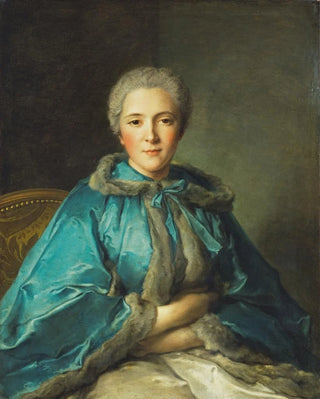Art print | The Countess of Tillières - Jean-Marc Nattier


View from behind

Frame (optional)
Reproduction The Countess of Tillières - Jean-Marc Nattier – Captivating Introduction
In the vibrant world of 18th-century French painting, the artwork "The Countess of Tillières" by Jean-Marc Nattier stands out for its elegance and delicacy. This portrait, imbued with an atmosphere that is both intimate and refined, immerses us in the world of Parisian salons, where art and high society intertwine. The depiction of the countess, with her penetrating gaze and graceful posture, evokes not only physical beauty but also the complex personality of this iconic figure. Through this piece, Nattier manages to capture the very essence of his model, while offering a fascinating glimpse into the Rococo era, marked by exuberance and attention to detail.
Style and uniqueness of the work
Nattier's style is characterized by an exceptional mastery of colors and textures, which bring his subjects to life. In "The Countess of Tillières," the soft and luminous nuances of the countess's clothing, as well as the finesse of her face, testify to a refined pictorial technique. The choice of drapery, the fluidity of lines, and the harmony of colors create a balanced and captivating composition. Every element of the canvas, from the delicate background to the carefully chosen accessories, contributes to the overall elegance of the work. Nattier excels in the art of highlighting feminine beauty, and this portrait is a perfect illustration of that. The subtly diffused light accentuates the delicate features of the countess's face, while her gentle gaze seems to invite the viewer to share a moment of intimacy.
The artist and his influence
Jean-Marc Nattier, an emblematic figure of 18th-century portraiture, established himself as one of the most sought-after artists of his time. Trained in his father's workshop, who was also a painter, Nattier quickly developed a style that was uniquely his own, combining technical finesse with sensitivity. His career was marked by commissions from the royal court, and he became the official portraitist of many nobles and aristocrats. Nattier's influence extended to...

Matte finish

View from behind

Frame (optional)
Reproduction The Countess of Tillières - Jean-Marc Nattier – Captivating Introduction
In the vibrant world of 18th-century French painting, the artwork "The Countess of Tillières" by Jean-Marc Nattier stands out for its elegance and delicacy. This portrait, imbued with an atmosphere that is both intimate and refined, immerses us in the world of Parisian salons, where art and high society intertwine. The depiction of the countess, with her penetrating gaze and graceful posture, evokes not only physical beauty but also the complex personality of this iconic figure. Through this piece, Nattier manages to capture the very essence of his model, while offering a fascinating glimpse into the Rococo era, marked by exuberance and attention to detail.
Style and uniqueness of the work
Nattier's style is characterized by an exceptional mastery of colors and textures, which bring his subjects to life. In "The Countess of Tillières," the soft and luminous nuances of the countess's clothing, as well as the finesse of her face, testify to a refined pictorial technique. The choice of drapery, the fluidity of lines, and the harmony of colors create a balanced and captivating composition. Every element of the canvas, from the delicate background to the carefully chosen accessories, contributes to the overall elegance of the work. Nattier excels in the art of highlighting feminine beauty, and this portrait is a perfect illustration of that. The subtly diffused light accentuates the delicate features of the countess's face, while her gentle gaze seems to invite the viewer to share a moment of intimacy.
The artist and his influence
Jean-Marc Nattier, an emblematic figure of 18th-century portraiture, established himself as one of the most sought-after artists of his time. Trained in his father's workshop, who was also a painter, Nattier quickly developed a style that was uniquely his own, combining technical finesse with sensitivity. His career was marked by commissions from the royal court, and he became the official portraitist of many nobles and aristocrats. Nattier's influence extended to...






